Scratches From A Hacksaw
by Mike Miller
Reprinted from "Crown Jewels of the Wire", March 1998, page 7
The well watered Wet Mountain Valley, lying to the East of the stately Sangre
de Cristo mountain range, had begun to be settled in the late 1860s by farmers
and stockmen. In J 872 it was found that the low hills to the east of the valley
contained lead and silver sulfide (Galena and Argentite) The town, that sprang
up was named Rosita and in the period of 1875-77 had a population of 1200 to
1500. The ore veins were shallow and soon pinched out.
In 1877, two miles
north of Rosita, Mr. Edmund C. Bassick crossing what is now known as Bassick
Hill to his job of driving a tunnel into Mt. Tyndall discovered some strange
appearing rock. He traded a load of firewood to have it assayed and immediately
quit working for wages. For the first 8 or 10 tons of ore he received over
$12,000. All very gratifying to his wife, no doubt, as a few days before she had
been refused credit for a packet of pins by a Rosita merchant. Within a year and
a half he had removed $500,000 in gold and silver. Adjoining the new mine and
mill arose the town of Querida, Spanish for "dearest one."
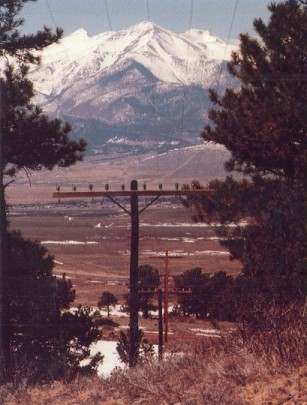
Large Image (271 Kb)
The,
following year, five miles to the west, a low black ledge was found to be made
of a greasy mineral which upon heating melted into a metal resembling silver.
This was horn silver (AgCl). The ground in this portion of the valley was soon
pitted with prospect holes and a third town sprang up, named for the ledge --
Silver Cliff. This town for a brief period was the third largest in
Colorado, exceeded only by Leadville and Denver. Here too, the ore was shallow
and only the Bassick remained productive, but it also had problems. E. C.
Bassick had sold the mine to a New York syndicate which seemed much more
interested in stock jobbing than mining. After a few years, mostly marked by
litigation, mining ceased in 1907. Of Querida, today nothing remains save for a
few broken bricks and shards of glass on the surface.
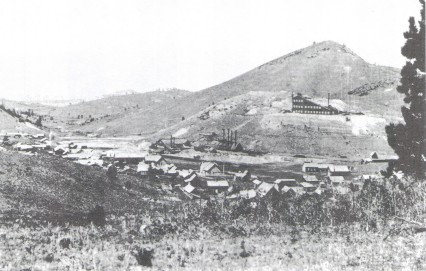
Medium Image (115 Kb)
Large Image (279 Kb)
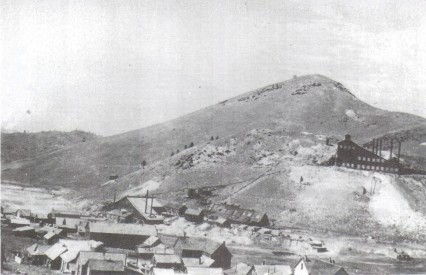
Medium Image (109 Kb)
Large Image (276 Kb)
Above are views of Bassick Hill and Mount Tyndall from the south.
(Photos
reprinted with permission of the Denver Public Library,
Western History
Collection, F-11908 and F-33530)
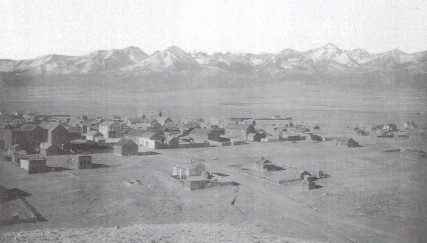
Medium Image (97 Kb)
Large Image (253 Kb)
Sangre de Christo Range from Silver Cliff, Colorado
(Photo reprint with
permission of the Denver Public Library,
Western History Collection, MCC-l300)
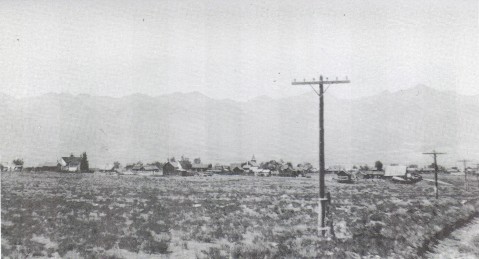
Medium Image (116 Kb)
Large Image (306 Kb)
Silver Cliff, Colorado -- Sept. 21, 1924
(Courtesy, Colorado Historical
Society, F39515)
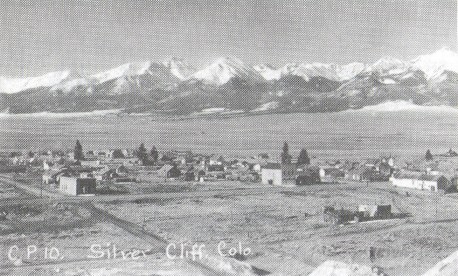
Silver Cliff, Colorado postcard which indicates the population to be 200
people.
(Private collection of author.)
A one pair toll line was built in 1902 by the Colorado Telephone Co. from
Canon City to the Wet Mountain Valley towns of Silver Cliff, Westcliffe and
Querida. To the Colorado Telephone Company, there appeared to be enough life to
justify bringing phone service to Querida. The western section of this line from
Silver Cliff was built with unembossed purple tramp tops, two per pole, used as
ordinary line insulators.
Perhaps it is not commonly known that unembossed two
piece tramps (CD 190 & 191) have been found in Colorado. In about 1960 a
pioneer collector from Denver, who wishes to remain anonymous, discovered this
line, now upgraded to a ten pin arm and removed many of the purple tops. It is
these insulators, which have occasionally turned up (Albuquerque 1990, Chicago
1997) mismatched to a Canadian bottom.
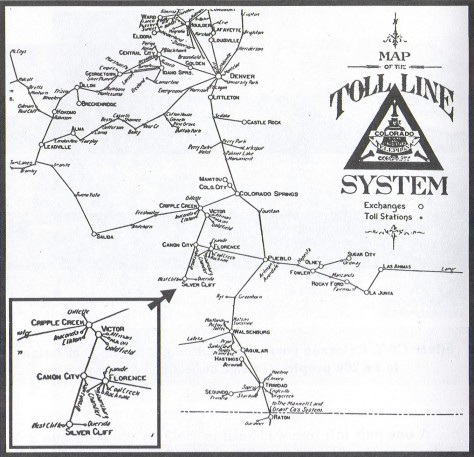
Map of the Toll Line System of the Colorado Telephone Company
from The
Cripple Creek Times, January 1, 1903
On Easter Sunday of 1987, I independently rediscovered this line, now with no
purple glass in the air, but with a few purple shards on the surface. Every free
weekend that summer and fall I raked, dug and probed that three mile stretch to
find a total of two mint specimens and a box filled with broken pieces. From the
massive conchoidal fractures of what is a very compact solid insulator, I
believe the telephone company at some point sent a lineman through to remove
with a hammer the remaining purple insulators in order to discourage the unknown
thief.
In the ten years since 1987 I have learned of, and have obtained a few,
mysterious tramps with characteristics and in colors to suggest Denver manufacture, specifically W.F.G.Co. I know of the
following quantities to exist.
|
Of the tops:
|
|
Dark purple
|
8
|
|
Medium Purple
|
1
|
|
Light purple
|
1
|
|
Bluish aqua
|
2
|
|
Steel blue
|
3
|
| |
|
|
|
Of the bottoms: |
|
Steel blue violet |
2 |
The broken tops found in 1987 ranged from dark purple through light purple to
a silvery, near clear beauty.
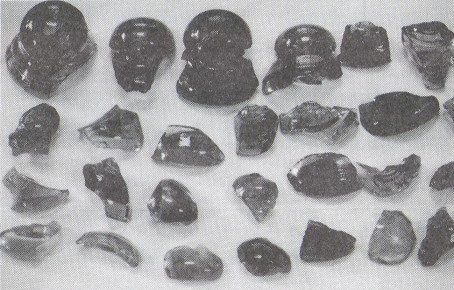
My initial find on this line was an intact dark purple. Later that same day I
found several broken tops. Of course my first reaction was what in the world are
Canadian tramp tops doing in Colorado? Or had I taken a wrong turn and these
were really the Selkirks in British Columbia ahead of me.
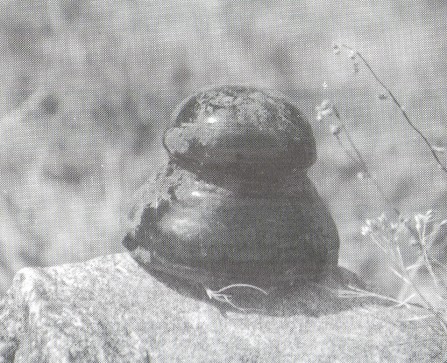
Top from a Denver two-piece transposition
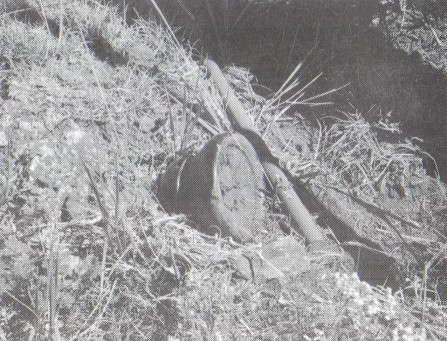
On returning to Denver, I compared my new top with a Canadian tramp top.
Except for the color there were numerous differences. The most obvious are:
1. The dome of the Denver is 1/8" wider than that of the Canadian,
making a noticeably flatter dome.
2. The exterior of the skirt rises vertically from the base of the Denver,
while that of the Canadian slopes slightly inward.
3. The interior skirt area of the Denver is more or less filled with glass.
This is variable as would be expected with a hand gathered operation such as the
Denver plants had. In the Canadian the interior of the skirt is open.
4. The pinhole of the Denver is wider than that of the Canadian. So much so
that the threads of the Denver do not engage securely with those of a pin.
5. The top of the pinhole of the Denver is flat and is usually marked with
scratches. In the Canadian the top of the pinhole is concave and is without
scratches.
I expect that the molds of the Denver two piece were made locally and the
thread mandrel was adapted from that of a taller insulator, such as a toll, by
hacksawing off the end of the mandrel. Since a pin and therefore the mandrel
that forms the pinhole is a frustum of a cone, this would lead to the
characteristics described in items 4 and 5 above.
So far I have written of these
pieces as being of Denver manufacture. Can I prove it? No, but I think a strong
likelihood can be demonstrated. The date the Silver Cliff line was built would
not exclude any of the three Denver plants. On the eastern portion of the line
towards Querida, I did not find any tops but did find several R. Good Jr. tolls
in purple, also broken. While purple is synonymous with other manufacturers as
well as with Denver, the purple tops do exhibit the same graininess as do most
R. Good purple insulators.
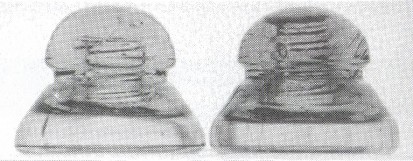 |
|
CANADA |
DENVER |
|
This photo shows the vertical rise of the
skirt and also the flatter broader
dome of the Denver |
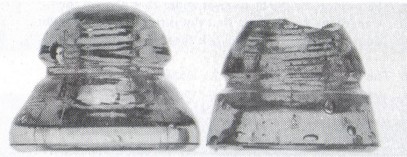
Denver top and bottom
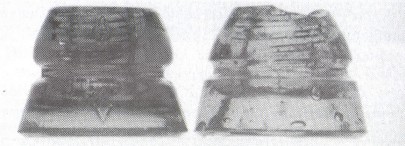 |
|
CANADA |
DENVER |
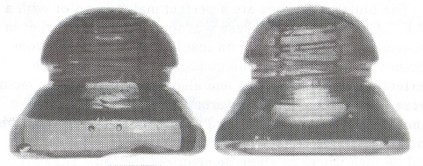
Two Denver tops showing the variability of the amount of glass filling in
the
skirt. The one on the left is a slight underpour.
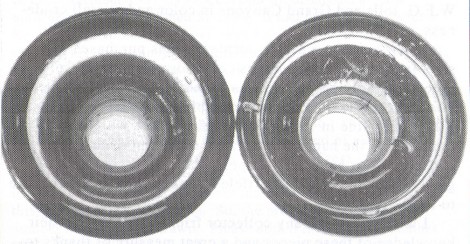 |
|
CANADA |
DENVER |
|
This photo indicates the larger pinhole of the Denver |
|
The photo to the right shows the flat top of the pinhole with the
hacksaw-like scratches.
|
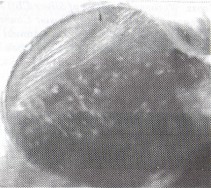 |
The bluish aqua tops are a perfect match in color with a W.F.G.Co. toll. One
of these was found at a flea market in Denver brought with common insulators by
a couple from northeastern Colorado. The three steel blue tops match perfectly
with W.F.G. tolls and also Grand Canyons. One of these was found at a Denver
area flea market 20 years ago. Another was found by a retired Mountain Bell
employee who had saved a vast quantity of insulators over his career but had no
idea where or when he acquired the top. The two steel blue violet bottoms were
removed from poles by another retired Mountain Bell lineman. These were stated
to have been found near Greeley, Colorado. They also match W.F.G. tolls and
Grand Canyons in color and overall crudeness.
A few years ago a dark purple top
was purchased at a shop in Westcliffe by a Texas collector poaching in Colorado.
The light purple top was found by a Colorado collector in a shop in Victor, Co.
Of the purple tops removed from the Silver Cliff line in 1960, I know of only
one which has remained in the hands of a collector who knew its origin. I expect
the rest have been dispersed and their significance gone unrecognized. This
article I hope will bring many more to light.
I wish to thank many collector
friends for sharing their knowledge of these pieces and a great measure of
thanks to Ray Curiel for taking the Denver/Canadian comparison photos.
Bibliography:
Cross, Whitman Geology of Silver Cliff and the Rosita Hills,
Colorado
Emmons, S.F. The Mines of Custer County, Colorado U.S. Geological
Survey 17th Annual Report Part II n.d. (ca 1899)
Eberhart, Perry Guide to the
Colorado Ghost Towns and Mining Camps Second Edition, Sage Books, Denver 1959
Fossett, Frank Colorado its Gold & Silver Mines Farms & Stock Ranges
Second Edition, C.G.Crawford, New York 1880
Rizzari, Frank B., editor, The
Westerners Brand Book, Vol XX, "Bassick and His Wonderful Mine" by
Will Rathbun and Edwin A. Bathke, Johnson Publishing Co. Boulder, Colorado 1965
The Cripple Creek Times, January I, 1903
The Denver Times January 15, 1903
The
Colorado Telephone Company "Toll Line Wire Map Colo.& New Mexico"
1908
A holding of Western History Dept. Norlin Library, University of Colorado,
Boulder
| 